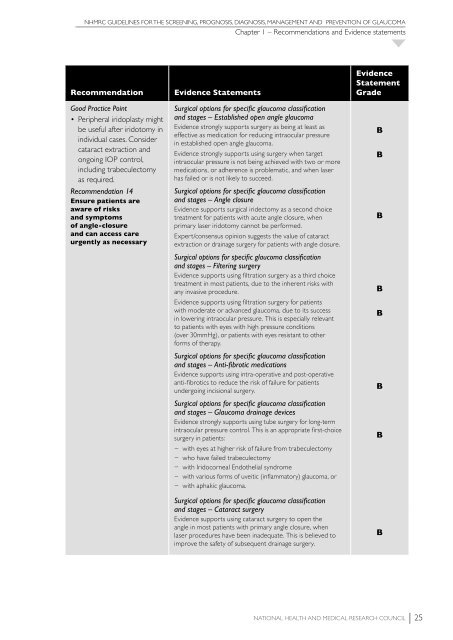NHMRC Glaucoma Guidelines - ANZGIG
NHMRC Glaucoma Guidelines - ANZGIG
NHMRC Glaucoma Guidelines - ANZGIG
Create successful ePaper yourself
Turn your PDF publications into a flip-book with our unique Google optimized e-Paper software.
<strong>NHMRC</strong> GUIDELINES FOR THE SCREENING, PROGNOSIS, DIAGNOSIS, MANAGEMENT AND PREVENTION OF GLAUCOMA<br />
Chapter 1 – Recommendations and Evidence statements<br />
Recommendation<br />
Good Practice Point<br />
• Peripheral iridoplasty might<br />
be useful after iridotomy in<br />
individual cases. Consider<br />
cataract extraction and<br />
ongoing IOP control,<br />
including trabeculectomy<br />
as required.<br />
Recommendation 14<br />
Ensure patients are<br />
aware of risks<br />
and symptoms<br />
of angle-closure<br />
and can access care<br />
urgently as necessary<br />
Evidence Statements<br />
Surgical options for specific glaucoma classification<br />
and stages – Established open angle glaucoma<br />
Evidence strongly supports surgery as being at least as<br />
effective as medication for reducing intraocular pressure<br />
in established open angle glaucoma.<br />
Evidence strongly supports using surgery when target<br />
intraocular pressure is not being achieved with two or more<br />
medications, or adherence is problematic, and when laser<br />
has failed or is not likely to succeed.<br />
Surgical options for specific glaucoma classification<br />
and stages – Angle closure<br />
Evidence supports surgical iridectomy as a second choice<br />
treatment for patients with acute angle closure, when<br />
primary laser iridotomy cannot be performed.<br />
Expert/consensus opinion suggests the value of cataract<br />
extraction or drainage surgery for patients with angle closure.<br />
Surgical options for specific glaucoma classification<br />
and stages – Filtering surgery<br />
Evidence supports using filtration surgery as a third choice<br />
treatment in most patients, due to the inherent risks with<br />
any invasive procedure.<br />
Evidence supports using filtration surgery for patients<br />
with moderate or advanced glaucoma, due to its success<br />
in lowering intraocular pressure. This is especially relevant<br />
to patients with eyes with high pressure conditions<br />
(over 30mmHg), or patients with eyes resistant to other<br />
forms of therapy.<br />
Surgical options for specific glaucoma classification<br />
and stages – Anti-fibrotic medications<br />
Evidence supports using intra-operative and post-operative<br />
anti-fibrotics to reduce the risk of failure for patients<br />
undergoing incisional surgery.<br />
Surgical options for specific glaucoma classification<br />
and stages – <strong>Glaucoma</strong> drainage devices<br />
Evidence strongly supports using tube surgery for long-term<br />
intraocular pressure control. This is an appropriate first-choice<br />
surgery in patients:<br />
−−<br />
with eyes at higher risk of failure from trabeculectomy<br />
−−<br />
who have failed trabeculectomy<br />
−−<br />
with Iridocorneal Endothelial syndrome<br />
−−<br />
with various forms of uveitic (inflammatory) glaucoma, or<br />
−−<br />
with aphakic glaucoma.<br />
Surgical options for specific glaucoma classification<br />
and stages – Cataract surgery<br />
Evidence supports using cataract surgery to open the<br />
angle in most patients with primary angle closure, when<br />
laser procedures have been inadequate. This is believed to<br />
improve the safety of subsequent drainage surgery.<br />
Evidence<br />
Statement<br />
Grade<br />
B<br />
B<br />
B<br />
B<br />
B<br />
B<br />
B<br />
B<br />
National Health and Medical Research Council 25





